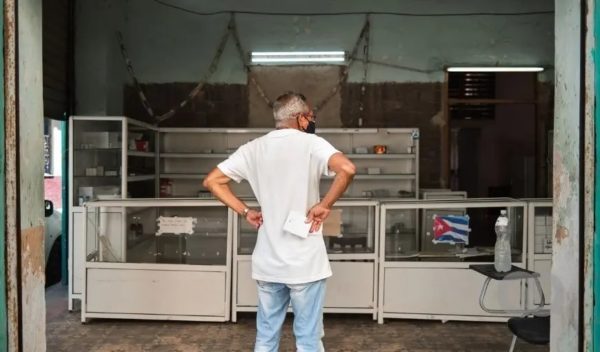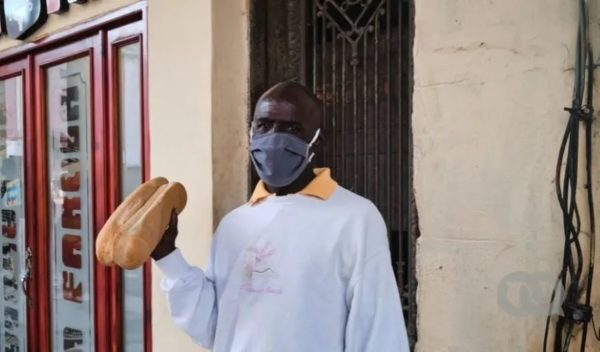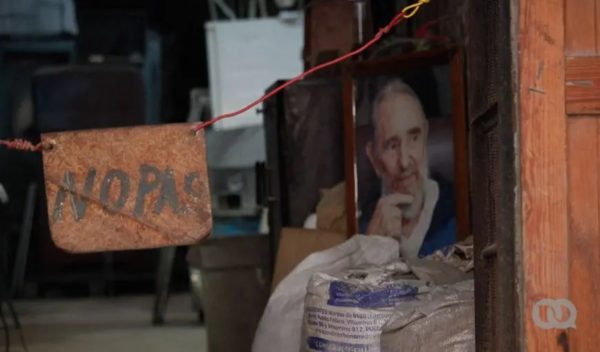Cuba Lost in its Currency Labyrinth

By Alberto C. Toppin and Amaury Valdivia (El Toque)
HAVANA TIMES – On July 11, 2021, thousands of Cubans took to the streets to protest. In addition to freedom, they were also asking for food and medicine. According to official discourse, the cause of food shortages lies in the combination of the US embargo/blockade and its consequences, as well as COVID-19 in the country. However, food insecurity in Cuba didn’t begin with the pandemic, nor is it only due to the impact of others foreign policy.
In January 2021, Jorge Noris got a pay rise; but now he buys less and it isn’t exactly because he’s trying to save money. The 4000 Cuban pesos he earns in wages (166 USD at the official exchange rate, around 65 USD on the street) fly from his hands between electricity bills, and rationed hygiene and food products. He must turn to the illicit market, with its high prices and without guarantees, in order to buy clothes, shampoo or a light bulb for his house, in Havana’s San Miguel del Padron municipality. There are almost no stores in the Cuban capital that offer these products regularly in Cuban pesos, the country’s official currency.
Jorge Noris is over 30 years old and works for a government agency linked to I.T. and telecommunications. Before 2021, he earned approximately 2300 pesos per month. Before COVID-19 hit Cuba, this sum allowed him to buy chicken, hamburgers, minced meat, choose between different personal hygiene brands and take some candy home for his two children. Buying a light bulb with his wages only depended on whether they were in stock at the store.
Today, most of these products are only available on the illicit market at prices that go as high as triple official retail prices. Buying them in US dollar stores (called Freely Convertible Currency, MLC) belonging to the State requires patience and luck, and the inevitable process of exchanging Cuban pesos for USD “on the street”. For months now, the dollar stores have been the main source of supplies for the island’s population. Similar stores in national currency are always pretty much empty.

In late 2020, the Cuban government undertook its greatest economic reform in the last few decades, called Tarea Ordenamiento (economic reforms process). It sought to solve age-old problems within the national economy, as well as increase citizens’ purchasing power, revalue the Cuban peso as the official currency by eliminating the Convertible peso and establishing a single exchange rate for Cuban pesos against foreign currencies.
Over six months later, none of these objectives have been met. Wages can’t be used to buy in better-stocked stores; prices on the illicit market, including the price of foreign currency, has shot through the roof; the Cuban peso, dollar and euro are all circulating; and the price of US dollars between Cubans on the street is over double the exchange rate established by the Central Bank, although they are selling dollars anyway.
Before the economic reforms, there were several exchange rates in Cuba between the Cuban peso, the Convertible Cuban peso and the USD. Citizens could only use the first two currencies, which were exchanged for 24 regular pesos for 1 Convertible peso. In December 2020, Marino Murillo Jorge, the head of the committee to implement economic reforms, argued that this situation would be resolved “without another devaluation for citizens.” In order to do this, the exchange rate of 1:24 between the Convertible Cuban peso and the Cuban peso was changed instead to 1 USD = 24 Cuban pesos.
According to economist Pavel Vidal, who worked as an expert at the Cuban Central Bank and is a professor at the Pontifical Xavierian University in Cali, Colombia, the Cuban peso has been devalued up to 10 times. “With a process of this magnitude, the inflationary impact is huge,” he warned.
The new value was set at a time when the Government didn’t guarantee – and still doesn’t guarantee – the exchange of Cuban pesos to USD at its bank branches. Plus, the abovementioned dollar (MLC) stores have existed since late 2019, which constitute a parallel market that is run by the state-led retail network of stores where basic essentials are sold in foreign currency.
Unlike the rest of Cuba’s retail establishments, you can only pay in these stores with an electronic card that has had foreign currency deposited on it. In the beginning, the government said that these stores opened up to ensure supplies in peso stores (CUP and CUC) stores, which were weaker currencies. According to Raul Castro, this would happen by incentivizing “remittances from Cuban citizens abroad, who send money back to their relatives on the island.” President Miguel Diaz-Canel said that this would happen by collecting cash in circulation. In June, during a Council of Ministers session, the leader defended the controversial retail modality, by saying that “if we hadn’t done it, shortages today would have been a lot worse.”
“The people who don’t buy in foreign currency stores don’t eat, nor do they have anything to wear, nor can they buy something they need from the hardware store,” Jorge Noris weighed in. As the Government doesn’t sell foreign currency and if you don’t have relatives to send it to you, you have to buy it on the illicit market.

The minimum wage in Cuba after the economic reforms was fixed at 2100 Cuban pesos. The Government calculated that this sum would be enough to cover a “basic basket” that would include food and “other goods and services” that were never defined.
When the economic reforms process began on January 1st, the dollar’s price on the illicit market ranged between 35-40 pesos. In spite of the fact that selling foreign currency outside institutions is a crime and that the Cuban president called for it to be dismantled, the Cuban peso continues to be scorned to the point that it could be exchanged for up to 70 pesos : 1 USD at the beginning of June 2021: almost 3 times the value established by the Cuban government. With devaluation, real minimum wages in Cuba went from 60 USD to 30 USD: the average before the reform.
The last time Jorge Noris bought USD, they cost him 55 Cuban pesos. “I can’t afford to pay more for them with a house and family to maintain,” he says. He is now a customer of resellers (who are also illegal, buying their stock from foreign currency stores) and he manages to buy food and personal hygiene products in the few state-run online stores that have supplies.
Something similar happened to Alfredo*, a masseur in Havana’s Boyeros municipality.
“The body lotions I work with can cost from 3 -12 USD in stores, depending on the quality,” he explains. “These same lotions are sold by resellers for 350 – 1000 Cuban pesos, now that the USD is between 60-65 pesos. Before the reforms, he used to buy them at stores in Cuban pesos and his services were 50% cheaper.
In spite of independent workers like Alfredo only having access to their raw materials in foreign currency stores, the Government has established that this sector can only offer their products and services in Cuban pesos, with very few exceptions. Alfredo sidesteps this restriction. One of his clients pays for his services in foreign currency, taking the dollar value of 60 Cuban pesos as their reference. This money pays for the lotions when he can’t find them with illegal resellers. When he only has pesos, Alfredo looks for a neighbor in the neighborhood to sell him the US currency for less than 65 pesos. Up until June 21st (the end date that the Cuban Central Bank would accept cash deposits in USD), he prefered cash.
He initially thought that he could charge for his services in both currencies, USD and Cuban pesos, but with the Reforms Process, over half of his clients stopped having enough money to hire him. Most of his clients who continue with him pay in Cuban pesos.
With the tourism industry plummeting because of COVID-19 and a drop in revenue from medical missions abroad, remittances are key for foreign currency to enter the country. “Remittances are a source of income which gain importance with their structural participation in the economy, because other sources of income decrease,” the minister of Economy and Planning, Alejandro Gil, said on national TV in late 2020. He didn’t offer approximate figures of just how much money enters the country via this channel, that year.
Furthermore, Gil emphasized that “remittances are not collected with short-supplied stores.” Foreign currency stores were announced as a lifeline for Cubans who received family remittances and anyone who has access to foreign currency by other means, amidst this crisis of shortages. While the Cuban government assured that other retail networks in pesos wouldn’t be neglected, previous experiences suggested that there would be a great gap between their intentions and reality.
“Right now, it’s really hard to find cigarettes at a store that isn’t a foreign currency one,” Rosy Fonseca says, a young woman living in the Central Havana municipality, who receive dollars every month by transfer from the US. “Quality tomato sauce, chickpeas, split chickpeas, wet wipes… you can’t find any of these in Cuban pesos.”
Rosy Fonseca feels fortunate to have foreign currency on her card. “If I didn’t have anyone to send me this money for some reason, I wouldn’t have access to any products sold in foreign currency, because I wouldn’t buy them given the price of dollars on the street, it’s extorsion,” she confesses.
Under the opening in the Obama era, Western Union established a network of 407 offices in Cuba and really facilitated the entry of family remittances (not only from the US) and other payments to people in Cuba. However, in November 2020, as a result of a sanction imposed by then president Donald Trump, the company was forced to close down its operations in the country and thus the main channel for money transfers was cut. Biden said that he would reverse these sanctions, but he hasn’t done so up until today.

“Since January, with the opening of more foreign currency stores, the explosion in dollar value, reductions in flights from and to the US and almost zero circulation of the dollar, considerable growth could be seen in demands for remittances services,” Marlen says, a 27-year-old Cuban who has a business to send money from the US to Cuba. Her business demands a payment of 140 USD to a foreign account to then send 100 in cash to Cuba or via a bank transfer. Many of Marlen’s clients confirm that the dollar has greater purchasing power than the Cuban peso because it can be used in foreign currency stores or sold. Contrary to the government’s initial discourse, only dollars can be used to buy a wide range of products that have migrated from stores in Cuban pesos to those in freely convertible currency.
In July 2020, Hector Oroza, president of the CIMEX corporation – one of the companies subordinated to the Business Administration Group, considered the economic arm of the Ministry of Revolutionary Armed Forces – announced that some products will continue to be sold in Cuba’s official currency. He cited tomato sauce, wet wipes, grains, crock-pots, yoghurt, beer, malt, national sodas, coffee, flour, cold cuts and other things.
In this regard, minister Gil denied that products to be sold in foreign currency were being taken from other stores. “This isn’t and will never be Cuba,” he said.
A year later, electrical appliances and national products such as soda, yoghurt, meat, flour, coffee, shampoo and beer are being sold exclusively in foreign currency, a phenomenon that is known as “exports on the border”, according to the economist Pedro Monreal, and could get worse. Leticia Morales, vice-minister of Economy and Planning, said on national TV that there were intentions to extend the foreign currency network of stores. However, forecasts indicate that the Cuban economy might suffer inflation up to 500% in 2021, and will only start recovering after 2023.

While the economic reforms weren’t the cause of shortages in Cuba, economists like Monreal note they plays a significant part in things getting worse. On the one hand, wages and prices went up, but not products for sale to Cubans like Jorge Noris, who began to see more money in his hands. Likewise, Cuban officials conceived the Economic Reforms Process during years past when all the variables were under control. However, it’s implementation in 2021 has ended up being a very difficult process of trial and error.
—–
*The person interviewed asked for their identity to be changed in the article, out of fear of reprisals.
Text written in collaboration with CONNECTAS.






Cuba’s currency woes will only get worse unless the dictatorship opens the local market to foreign investors. Only then will foreign currency increase to an extent to sufficient to sustain the moribund Cuban economy. Short of this fix, the regime is simply rearranging the deck chairs on the Titanic.
Hey Nick! I note that your nationality is in doubt! Welcome to Canada!
The central planners of the Communist Cuban Government are totally naive as to the basic premise of economics. If there is a declining supply of goods for purchase, and a static or increasing demand for those goods, the price will go up. It simply doesn’t matter what the government says the price should be, the imbalance between supply and demand will always result in a higher price, because those who most want a product will pay a little more to get it. Increasing the government’s monthly payment to people, without increasing the supply of goods available for purchase, is what has resulted in higher prices for the limited goods available.
The real problem is the Communist Cuban Government’s inability to produce goods or services. Despite acres of potentially productive land, Cuba imports 70-80% of food. It has gone from the world’s leading sugar producer to a net importer of sugar. It doesn’t have any factories. It can’t produce cars, glass, tools, clothing or electronics. It has nothing to export except cigars and rum….which have limited and competitive international markets.
Cuba has become a beggar nation, dependent upon the generosity of others and “remittances” (gifts) to its people.
It is so sad.
A tale of woe. Maybe even sycophants of the regime can comprehend why Cubans demonstrated on July 11th, 2021. One wonders if they still approve the repression, trials and imprisonments that followed?